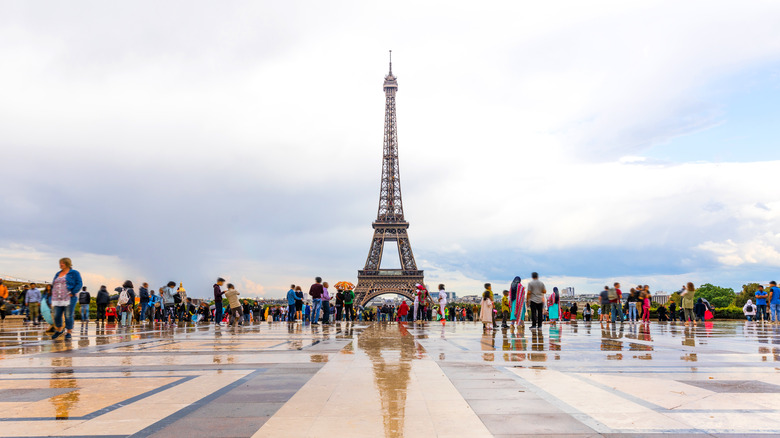The Sweet Treat That Becomes A Tourist Trap When Visiting Paris
Europe is full of can't-miss destinations for food lovers, with Paris at the top of many a foodie's bucket list. From croissants and baguettes to crème brûlée and crepes, the City of Lights is particularly well known for its baked goods, with the macaron as one of Paris' most famous sweet treats. There's one word that's become synonymous with Paris and macarons — Ladurée.
A world-renowned luxury bakery chain, Ladurée also represents the epitome of a Parisian tourist trap by requiring people to wait in a long line to pay some of the highest prices in the city for delicate, round sandwich cookies that aren't even made in-house. Instead, they're made at a factory outside Paris and brought in. To clarify, the French macaron served at Ladurée and other pâtisseries across Paris should not be confused with macaroons, the coconut-covered drop cookie. The modern Parisian macaron is made from brightly colored almond meringue shells that are baked and then put together with jam, ganache, or buttercream frosting as fillings.
One of Rick Steves' top European travel tips is to act like a "temporary local" (via Forbes). While the macaron is nearly inextricably linked to Ladurée and Paris itself, we noticed that Ladurée isn't really the go-to location for locals to get macarons.
Ladurée can be crowded and pricey
When you visit Ladurée, you're likely to find yourself surrounded solely by other tourists — particularly, we noticed, at their flagship store on the Champs-Elysées. When you go to order, the staff may speak to you in English, which can be helpful if you don't speak French, but it's not really an authentic Parisian bakery experience. There are plenty of non-chain, lesser-known pâtisseries and bakeries in Paris making macarons just as tasty as the ones from Ladurée. They're also likely serving them for half the price – a macaron from Ladurée can cost upwards of $3.
With those marks against Ladurée, why do people keep going? Going to the original one could be like going to the first Starbucks in Seattle — it's not serving anything new, but for fans, it's a must-visit no matter the cost. With all the hype around it, you're not just paying for the macaron, you're paying to say you got a macaron from Ladurée in Paris.
For others, it may be worth going at least once, considering the history of the bakery. In 1862, Louis Ernest Ladurée opened the first pastry shop and tea room under his name at 16 rue Royale in Paris near the Tuileries Gardens, and there's still a Ladurée there today.
Macarons have a long history in Paris
Fast forward to 1930: Pierre Desfontaines, a descendent of the luxury bakery's founder, conjured up the idea for the macaron as a sandwich cookie, according to the Ladurée website. Others, however, claim it was French pastry chef Claude Gerbet who came up with the idea around the same time.
According to legend, the macaron's history in Paris goes back to the 1500s, when it was a favorite treat of Catherine de' Medici, wife of French King Henri II, per the Taste of France. It purportedly stayed a popular aristocratic treat, and was even served at Versailles for guests of King Louis XIV. Macarons' status as fit for French royalty was reinforced by Hollywood — Kirsten Dunst ate Ladurée macarons as the title character in Sofia Coppola's movie "Marie Antoinette." Dunst later told Entertainment Weekly, "Sofia and I kick ourselves; we should have invested in Ladurée [...] because those stores popped up everywhere." There are indeed multiple Ladurée locations in Paris, including at Charles de Gaulle, one of Europe's most stressful airports, and dozens of others around the world.
The best macaron, though, is the one you like the best, and the range of options in Paris goes far beyond Ladurée – you can even get them from McDonald's! Try them from different spots and find what you like best beyond the store they come from — chewier or lighter, classic or experimental flavors, delicate or in-your-face taste — find your favorite.


